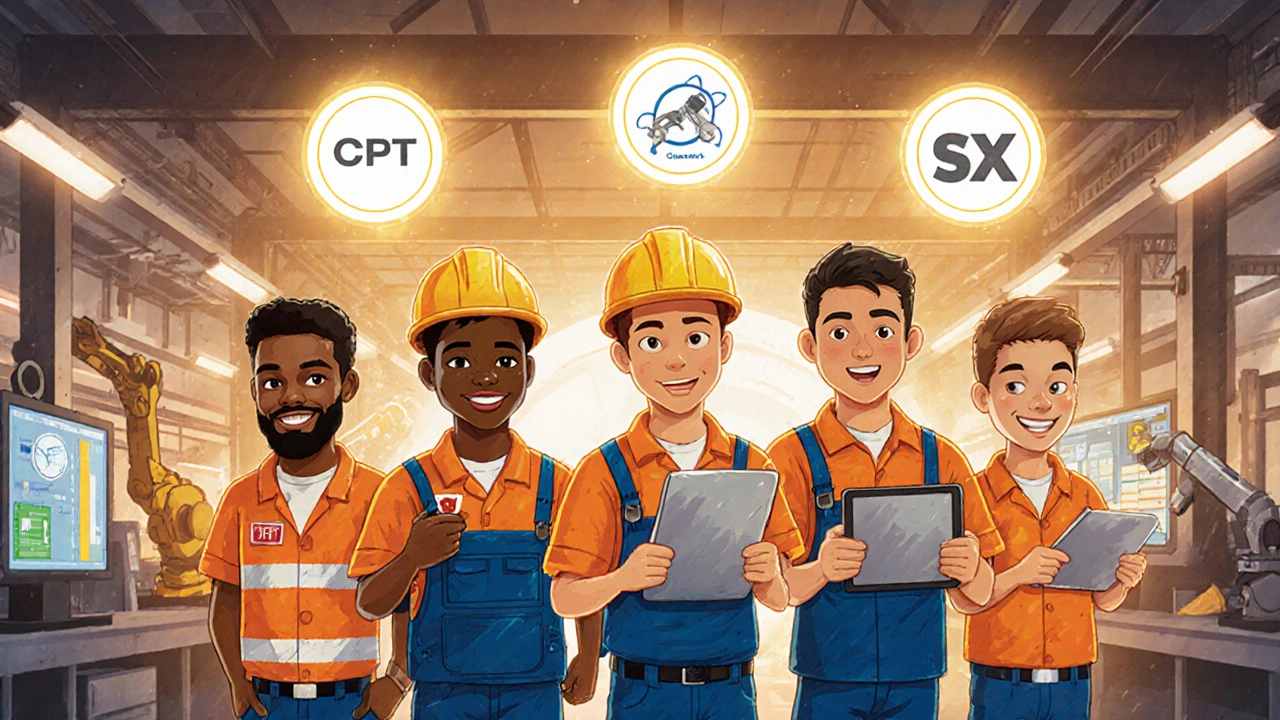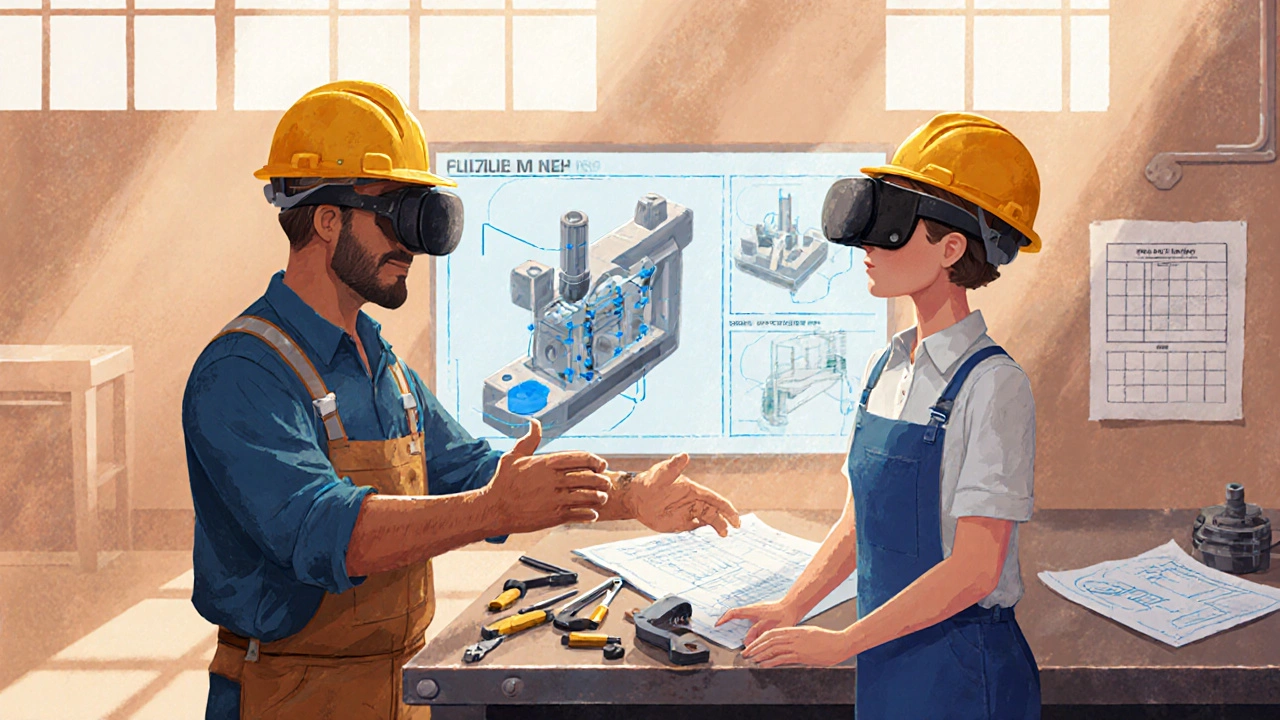Personnel Training: Qualifications for Manufacturing Staff

When you walk into a modern manufacturing plant, you don’t just see machines. You see people - trained, certified, and constantly learning. The truth is, the best robots and automated lines mean nothing without workers who know how to use them, fix them, and keep them running safely. That’s why personnel training isn’t just a nice-to-have in manufacturing - it’s the backbone of quality, safety, and efficiency.
What Qualifications Do Manufacturing Staff Actually Need?
Not every job on the floor requires a college degree. But that doesn’t mean anyone can walk in and start operating a CNC machine. Qualifications are tiered, and they match the job. Entry-level positions - like material handlers or basic assembly line workers - typically only need a high school diploma or GED. In fact, 92% of manufacturers accept this as the minimum baseline, according to RSS Inc. (2023).
But if you want to move up - to run a machine, inspect parts, or lead a shift - you need more. That’s where certifications come in. The most common starting point is the Certified Production Technician (CPT) from the Manufacturing Skill Standards Council (MSSC). It covers four core areas: safety, quality practices, manufacturing processes, and maintenance awareness. It’s not a fancy degree, but it’s nationally recognized, portable, and tells employers you’ve been tested on real skills.
For more technical roles - welding, machining, or quality control - one to two years of community college training in programs like Mechanical Engineering Technology or Welding Technology is standard. These aren’t just classroom courses. They include hands-on labs, real tools, and often internships. Graduates from these programs have a 91% job placement rate, according to the National Center for Education Statistics (2022).
Safety Training Isn’t Optional - It’s Law
Every manufacturing job starts with safety. OSHA’s General Industry Standards (29 CFR 1910) aren’t suggestions. They’re legal requirements. That means every worker must be trained on proper PPE, lockout/tagout procedures, hazard communication, and emergency response. And it works: OSHA data shows that proper safety training cuts workplace injuries by 52%.
But here’s the problem - only 38% of small manufacturers do regular safety recertification, according to the National Safety Council (2023). That’s dangerous. Equipment changes. New chemicals arrive. Workers forget. A one-time training session isn’t enough. Annual refreshers, quarterly drills, and on-the-spot coaching are what keep people safe.
Manufacturers who track safety training completion digitally - using software that flags who’s due for renewal - see fewer incidents and lower insurance costs. It’s not just about compliance. It’s about keeping your team alive.
Technical Skills Are Evolving - Fast
Twenty years ago, a good machinist knew how to read blueprints and adjust a lathe. Today, they also need to understand how to interpret data from sensors, troubleshoot a PLC, and use digital work instructions on a tablet. That’s Industry 4.0 in action.
That’s why certifications are changing. ASQ, the American Society for Quality, updated its Six Sigma Green Belt exam in 2023 to include basic Python and SQL skills. Why? Because data-driven decision-making is now part of every quality role. If you can’t read a trend chart or spot an anomaly in a statistical process control (SPC) report, you’re not just behind - you’re a liability.
Even entry-level certifications like the Manufacturing Technician Level 1 (MT1) are adding digital modules. Pilot programs using AI-powered adaptive learning show workers master skills 22% faster than with traditional methods. That’s not science fiction - it’s happening now in Virginia, Ohio, and Michigan, where state funding helps train teachers to deliver these programs in high schools.

Six Sigma, Lean, and Other Certifications - Do They Matter?
Six Sigma gets a lot of attention. And for good reason. Green Belts earn a median salary of $85,000. Black Belts make $110,000. But here’s the catch: certification alone doesn’t guarantee results. ASQ’s own data shows retention rates jump from 57% to over 85% when certifications are paired with mentorship. Someone needs to show you how to apply what you learned.
Lean Manufacturing certifications require 40 to 160 hours of training, depending on the level. But the real value isn’t the certificate - it’s the mindset. Lean isn’t about cutting costs. It’s about eliminating waste: wasted motion, wasted time, wasted materials. Workers trained in Lean spot bottlenecks before they become problems. They suggest small improvements that add up to big savings.
And here’s something most people don’t realize: the best Lean practitioners aren’t always the engineers. They’re the line workers who’ve been doing the same job for five years. They know where the tool is always missing. Where the parts jam. Where the machine overheats. Training gives them the language to speak up - and the authority to fix it.
Apprenticeships vs. Certifications - What’s Better?
Traditional apprenticeships still exist. They’re paid, on-the-job programs that last 2 to 4 years. You learn from a master technician. You get classroom theory. You earn while you learn. But here’s the downside: these programs are rare. And the credentials often don’t transfer if you move to another company or state.
Nationally recognized certifications like CPT or MT1 solve that. They’re portable. They’re standardized. And they’re backed by data. The U.S. Department of Labor found that workers with CPT certification earn 76% more than those without. That’s not a small bump - that’s a career changer.
But certifications aren’t perfect. MIT’s Professor David Autor found that 43% of manufacturing certifications don’t actually predict job performance. Some are just expensive paper. That’s why smart employers don’t just look at the certificate. They test skills. They observe performance. They ask: Can this person actually do the job - not just pass a test?

Training Works - But Only If It’s Done Right
Companies that treat training like a checkbox end up with high turnover and low quality. Those that treat it like an investment see results. Here’s what works:
- Start with data. Look at your quality reports, downtime logs, and injury records. Where are the gaps? Train there.
- Use skills matrices. Track who can do what. Who needs help? Who’s ready for more?
- Combine methods. Mix classroom, hands-on labs, digital modules, and on-the-job coaching.
- Make it ongoing. Training isn’t a one-time event. It’s a habit.
- Empower workers. Let them lead safety huddles. Let them suggest process improvements. Give them ownership.
Manufacturers using documented development plans see 27% higher employee retention. Those using cross-training - where workers rotate through different stations - reduce resistance to new tech by 41%. And companies using augmented reality for complex assembly tasks report 39% fewer errors, according to user reports on Reddit’s r/manufacturing community.
The Big Picture: Why This Matters
By 2030, the Manufacturing Institute predicts 2.1 million manufacturing jobs will go unfilled because there aren’t enough trained workers. That’s not a rumor. It’s a forecast based on retirements, declining enrollment in technical programs, and the pace of automation.
But here’s the opportunity: every worker you train today becomes a multiplier. They mentor others. They reduce scrap. They prevent downtime. They keep the plant running. And when they feel valued, they stay.
It’s not about having the most certifications. It’s about building a culture where learning is expected, supported, and rewarded. Where a new hire isn’t just handed a manual - they’re given a path. Where a veteran worker isn’t left behind by new tech - they’re helped to adapt.
The future of manufacturing isn’t just machines. It’s people - properly trained, properly supported, and properly recognized.
Do manufacturing workers need a college degree?
No, not always. Entry-level roles only require a high school diploma or GED. But for technical positions - like machine operators, quality inspectors, or maintenance techs - one to two years of community college training in fields like welding or mechanical technology is standard. Engineering or management roles typically require a bachelor’s degree in industrial engineering or a related field.
What is the Certified Production Technician (CPT) certification?
The Certified Production Technician (CPT) is a nationally recognized credential from the Manufacturing Skill Standards Council (MSSC). It validates four core competencies: safety, quality practices, manufacturing processes, and maintenance awareness. It’s designed for frontline workers and is accepted by employers across the U.S. It’s often the first step up from entry-level roles.
How much does manufacturing training cost?
Costs vary widely. A CPT exam costs under $200. Community college manufacturing programs run $3,000-$8,000 per year for 18-24 months. University degrees cost $20,000-$50,000 per year. Six Sigma certifications range from $99 for White Belt to $5,000 for Master Black Belt. Many employers cover costs, and some states offer funding for workers and teachers.
Why is safety training so important in manufacturing?
Safety training directly reduces injuries. OSHA reports that proper training cuts workplace accidents by 52%. It’s also legally required under OSHA 1910 standards. Beyond compliance, it builds trust. Workers who feel safe are more productive, less stressed, and more likely to stay with the company.
Can older workers keep up with new manufacturing tech?
Yes - if they’re supported. 42% of manufacturing workers are 45 or older, and 61% need upskilling for new technologies. The key isn’t age - it’s approach. Hands-on training, peer mentoring, and simplified digital tools (like AR-guided instructions) help older workers adapt faster than traditional lectures. Many find they’re better at troubleshooting than younger workers because of their experience.
What’s the biggest mistake companies make with training?
Treating training as a one-time event. Many companies run a single safety class or certification course and assume the job is done. But skills fade. Machines change. New errors appear. The best companies make training ongoing, tied to performance data, and integrated into daily routines - not something you do once a year.